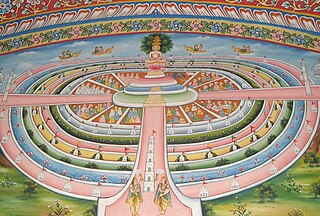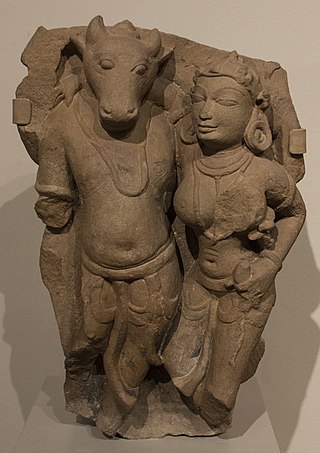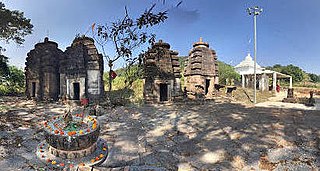
The Śvētāmbara is one of the two main branches of Jainism, the other being the Digambara. Śvētāmbara means "white-clad", and refers to its ascetics' practice of wearing white clothes, which sets it apart from the Digambara "sky-clad" Jains, whose ascetic practitioners go nude. Śvētāmbaras do not believe that ascetics must practice nudity.

Siddharth was the father of Mahavira, the 24th Jain Tirthankara. He was a Kshatriya King from the Ikshvaku dynasty and the ruler of the Nata, Ainwar (Light), Gyat or Jnatri clan in Kshatriya Kundagrama, a suburb of Vaishali He was married to Licchavi princess Trishala ( sister of King Chetaka of Vaishali.

Nemichandra, also known by his epithet Siddhanta Chakravarty, was a Jain acharya from present-day India. He wrote several works including Dravyasamgraha, Gommatsāra, Trilokasara, Labdhisara and Kshapanasara.

In Jainism, Samavasarana or Samosharana is the divine preaching hall of the Tirthankara, stated to have more than 20,000 stairs in it. The word samavasarana is derived from two words, sama, meaning general and avasara, meaning opportunity. It is an important feature in Jain art. The Samavasarana seems to have replaced the original Jain stupa as an object of worship.
Khottiga or Amoghavarsha IV, who bore the title Nityavarsha, was a ruler of the Rashtrakuta Empire. During this period the Rashtrakutas started to decline. The Paramara King Siyaka II plundered Manyakheta and Khottiga died fighting them. This information is available from the Jain work Mahapurana written by Pushpadanta. He was succeeded by Karka II who ruled only for a few months.
A manastambha is a pillar that is often constructed in front of Jain temples or large Jain statues. In North India, they are topped by four Tirthankara images.

The muhapatti is a square of white cloth worn across the face and tied behind the ears or held, by Sthanakvasi Svetambara or Śvētāmbara Terapanthi Jains. Sometimes a card is used instead of a cloth.

Sumatinatha was the fifth Jain Tirthankara of the present age (Avasarpini). Sumatinatha was born to a Kshatriya King Megha (Megharatha) and Queen Mangalavati (Sumangalavati) at Ayodhya in the Ikshvaku dynasty. His Janma Kalyanak (birthday) was the eighth day of the Vaisakha Sudi month of the Jain calendar.

Mallinatha was the 19th tīrthaṅkara "ford-maker" of the present avasarpiṇī age in Jainism. Jain texts indicate Mālliṇātha was born at Mithila into the Ikshvaku dynasty to King Kumbha and Queen Prajnavati. Tīrthaṅkara Māllīnātha lived for over 56,000 years, out of which 54,800 years less six days, was with omniscience.

Naminatha was the twenty-first tirthankara of the present half time cycle, Avsarpini. He was born to the King Vijaya and Queen Vipra of the Ikshvaku dynasty. King Vijaya was the ruler of Mithila at that time. Naminatha lived for 10,000 years. When Naminatha was in his mother's womb, Mithila was attacked by a group of powerful kings. The aura of Naminatha forced all the kings to surrender to King Vijaya.

Neminātha, also known as Nemi and Ariṣṭanemi, is the twenty-second Tīrthaṅkara of Jainism in the present age. Neminatha lived 81,000 years before the 23rd Tirthankara Parshvanatha. According to traditional accounts, he was born to King Samudravijaya and Queen Shivadevi of the Yadu dynasty in the north Indian city of Sauripura. His birth date was the fifth day of Shravana Shukla of the Jain calendar. Krishna, who was the 9th and last Jain Vasudev, was his first cousin.
Tiloya Panatti or Trilokaprajnapati is one of the earlier Prakrit texts on Jain cosmology composed by Acharya Yativrshabha.

Varanga is a village in Karkala Taluk in Udupi district of Karnataka, India. According to the 2011 census, it has a population of 4,011. This village is an important Jain center.

Dharmanatha was the fifteenth Jain Tirthankara of the present age (Avasarpini). According to Jain beliefs, he became a siddha, a liberated soul which has destroyed all of its karma. Dharmanath was born to King Bhanu Raja and Queen Suvrata Rani at Ratnapuri in the Ikshvaku dynasty. His birth date was the third day of the Magh Sukla month of the Indian calendar.

The Akota Bronzes represent a rare and important set of 68 Jain images, dating to between the 6th and 12th centuries AD, which were found in the vicinity of Akota near Baroda in the Indian state of Gujarat. It includes rare Gupta period bronzes that have been widely used for comparison of Gupta period art.
Harisena was a tenth century Digambara monk. His origin is traced to those monks who had stayed in the north during the supposed famine and had been prevailed upon by their lay followers to cover their private parts with a strip of cloth (ardhaphalaka) while begging for alms.

Jivantasvami images represent the Jain Tirthankara Mahavira as a prince, with a crown and ornaments. The Jina is represented as standing in the kayotsarga pose. Jivantasvami images have been used only in the Shvetambara Jain tradition, they are unknown in the Digambara tradition.

In Jain cosmology, Gomukha is the guardian god or Yaksha of Rishabhanatha, the first Tirthankara.

Subai Jain temples is a group of Jain temple in Subai village of Koraput district, Odisha.

The Pārśvanātha āyāgapaṭa, is a large stone slab discovered in Kankali which has an image of Parshvanatha, dating back to reign Sodasa, of Indo-Scythian Northern Satrap, the ruler Sodasa in Mathura. The tablet in the State Museum Lucknow. It is an important example of Mathura art.
















